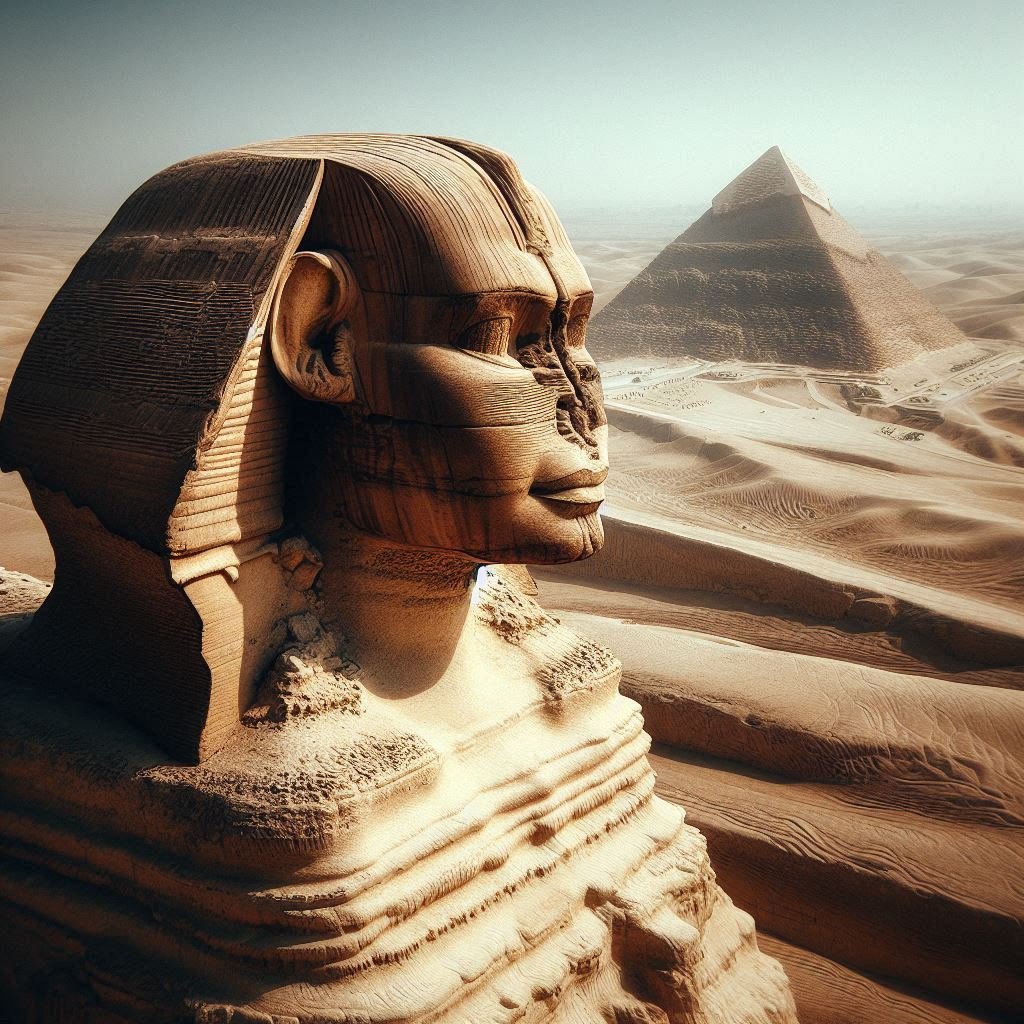Listen to “The Sphinx’s True Age” on Spreaker.
Imagine this.
You’re standing in the middle of the Egyptian desert. The air is dry, the sun is brutal, and in front of you… is a stone giant.
A body of a lion, muscles carved into rock, its frame stretching almost 240 feet across the desert floor. And above that body, a human head — calm, staring east toward the rising sun. That face has been locked in place for thousands of years.
This is the Great Sphinx of Giza. One of the most recognizable monuments in the entire world.
But here’s the thing.
For generations, archaeologists have been telling us the same story about this giant. But when a handful of scientists looked closer, they noticed something disturbing — something that suggested this monument might not be 4,500 years old, like we’ve been taught… but much, much older.
So old, in fact, that it could rewrite the entire history of human civilization.
This is the strange, dark, and mysterious story… of the Sphinx’s true age.
The Pharaoh’s Guardian
The official story goes like this:
About 4,500 years ago, during the reign of Pharaoh Khafre, workers carved the Great Sphinx out of the limestone bedrock of the Giza Plateau. Khafre is the same pharaoh responsible for building the second-largest pyramid at Giza, right next to the Sphinx.
The evidence seems pretty solid:
-
The Sphinx sits right in Khafre’s pyramid complex, surrounded by his mortuary temple and valley temple.
-
The blocks from the Sphinx’s temple are cut from the same stone as the Sphinx itself, and they match the style of Khafre’s other monuments.
-
There’s even a granite stele — basically a carved stone tablet — placed between the Sphinx’s paws by another pharaoh, Thutmose IV. This tablet mentions Khafre by name, implying he had something to do with the Sphinx, either building it or restoring it.
So for mainstream archaeologists, it makes perfect sense: Khafre built the Sphinx as his guardian. A monument with his face, protecting his pyramid for all eternity.
And honestly, if that’s where the story ended, the Sphinx would still be impressive.
But in the late 20th century… things got messy.
The Cracks in the Story
In the early 1990s, a geologist named Robert Schoch from Boston University visited the Sphinx. Now, Schoch wasn’t an Egyptologist. He didn’t study hieroglyphics or ancient kings. He studied rocks — specifically, how rocks weather and erode over time.
When he walked around the Sphinx’s enclosure — the massive carved-out pit the monument sits in — something caught his eye.
The walls didn’t look like they’d been weathered by wind and sand, the way you’d expect in a desert. Instead, they were full of deep, rounded grooves and vertical fissures. To Schoch, this didn’t look like desert erosion. It looked like water erosion — the kind you’d get from heavy rainfall pouring over rock for centuries.
But wait…
That doesn’t make sense. Because for the last 5,000 years, the Giza Plateau has been an arid desert. Hardly any rain at all.
So if the Sphinx’s enclosure really was carved and weathered by water, Schoch argued that it must date back to a time when Egypt wasn’t a desert — when the climate was much wetter. The last time that happened? Around the end of the Ice Age, between 10,000 and 12,000 years ago.
Let me pause here.
If Schoch was right, that would mean the Sphinx wasn’t 4,500 years old. It could be twice as old. Maybe even older. That’s a difference of over 7,000 years.
And here’s the problem: according to everything we’ve been taught, there were no advanced civilizations in Egypt 10,000 years ago. No pharaohs, no organized kingdoms, no massive stone monuments. Just small hunter-gatherer groups.
So if the Sphinx really was that old… who built it?
The Cosmic Connection
Now, Schoch wasn’t the only one raising questions. Around the same time, another group of researchers started looking at the Sphinx from a different angle — literally.
Writers like Graham Hancock and Robert Bauval noticed something odd about the Sphinx’s orientation. The Sphinx faces directly east, toward the rising sun during the spring equinox. That in itself isn’t shocking. But when they dug deeper into ancient astronomy, they noticed a potential pattern.
Because of a phenomenon called precession — basically, the slow wobble of the Earth’s axis — the position of the stars shifts over thousands of years. And if you rewind the sky back to around 10,500 BCE, something incredible happens.
At sunrise on the spring equinox, the constellation Leo — a lion — would have been rising directly in front of the Sphinx.
A lion facing the rising sun, under the constellation Leo.
Was this just a coincidence? Or had the builders of the Sphinx — whoever they were — carved it intentionally to align with the stars?
And if they did… that means they understood precession. They understood advanced astronomy. Knowledge we didn’t think humans had until much later.
If true, this would mean the Sphinx wasn’t just a monument. It was a cosmic marker, a clock carved into stone.
The Pushback
Of course, not everyone bought these theories. In fact, most mainstream Egyptologists rejected them completely.
Their counterarguments were sharp:
-
First, they said the erosion on the Sphinx could be explained by things like salt crystallization, dew, or occasional rainfall. Over thousands of years, those processes could create similar patterns to what Schoch was seeing.
-
Second, they pointed out that there is zero archaeological evidence for a lost civilization in Egypt 10,000 years ago. No tools, no settlements, no other monuments. Nothing.
-
And finally, they noted that the Sphinx’s head clearly looks like it was carved in the style of the Old Kingdom pharaohs. Probably Khafre himself.
For the water erosion theory to be true, they argued, it would mean the Sphinx’s body was thousands of years older than its head — meaning someone must have re-carved it later to look like Khafre. Possible? Sure. But extremely unlikely.
So the mainstream view held firm: the Sphinx was carved around 2500 BCE, during Khafre’s reign. End of story.
Except… the debate didn’t end.
What’s at Stake
Here’s why this argument matters so much.
If the Sphinx really is older than we think — if it really does date back to 10,000 BCE — then that means advanced civilizations existed long before the official start of history. It would mean humans had the knowledge and ability to create massive stone monuments thousands of years earlier than textbooks say.
It would force historians to completely rewrite the timeline of civilization.
And that possibility — that there could have been a forgotten, advanced culture wiped from history — is both thrilling… and terrifying.
Because if something like that did exist, what happened to it? What erased it so completely that the Sphinx might be the only thing left standing?
The Unfolding Mystery
Today, the debate rages on.
Modern tools like ground-penetrating radar and seismic surveys have been used around the Sphinx. Some early scans suggested there might be hidden chambers beneath it. Others showed anomalies in the bedrock. Nothing conclusive… yet.
Geologists continue to study the limestone, trying to determine if the erosion patterns really are from water. Egyptologists continue to uncover new evidence around the Giza Plateau, reinforcing the Old Kingdom timeline.
And the public? We’re left caught between two possibilities:
-
The Sphinx is exactly what we’ve been told it is — a 4,500-year-old masterpiece built by Pharaoh Khafre.
-
Or… it’s a relic from a lost civilization, tens of thousands of years old, staring across time as the last witness to an age we’ve completely forgotten.
The Silent Guardian
So next time you see a photo of the Sphinx — or better yet, if you’re lucky enough to stand before it in person — I want you to think about this:
You’re not just looking at a statue. You’re looking at a question carved in stone.
A question about who we are, where we came from, and what parts of our history might still be buried under the sand.
The Sphinx doesn’t speak. It just stares east, into eternity. But maybe, just maybe… it knows the answer.




